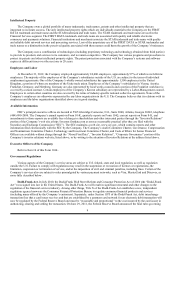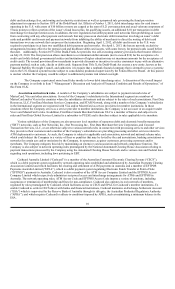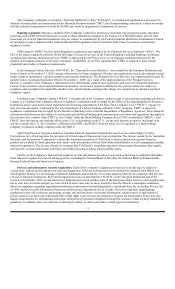First Data 2012 Annual Report Download - page 19
Download and view the complete annual report
Please find page 19 of the 2012 First Data annual report below. You can navigate through the pages in the report by either clicking on the pages listed below, or by using the keyword search tool below to find specific information within the annual report.
associated with foreign currency denominated transactions. However, these hedge contracts may not eliminate all of the risks related to
foreign currency translation. Furthermore, the Company is subject to exchange control regulations that restrict the conversion of its
revenue and assets denominated in Argentine pesos into U.S. dollars. Those regulations may become more restrictive in the future.
Similar regulations also may be adopted in other jurisdictions that restrict or prohibit the conversion of the Company’ s other foreign
currencies into U.S. dollars. The occurrence of any of these factors could decrease the value of revenues and earnings the Company
derives from its international operations and have a material adverse impact on the Company’ s business.
I
ncrease in interest rates may negatively impact the Company’s operating results and financial condition.
Certain of the Company’ s borrowings, including borrowings under the Company’ s senior secured credit facilities to the extent the
interest rate is not fixed by an interest rate swap, are at variable rates of interest. An increase in interest rates would have a negative
impact on the Company’ s results of operations by causing an increase in interest expense.
As of December 31, 2012, the Company had $8.3 billion aggregate principal amount of variable rate long-term indebtedness, of
which interest rate swaps fix the interest rate on $5.0 billion in notional amount prior to the impact of $750 million of fixed to floating
interest rate swaps. As a result, using balances as of December 31, 2012, a 10% proportionate increase in short-term interest rates on an
annualized basis compared to the interest rates as of December 31, 2012 would result in a $1.1 million increase in interest expense
related to the Company’ s balance of variable interest rate debt, net of interest rate swaps. Refer to the discussion of the Company’ s
interest rate swap transactions in Note 6 to the Company’ s Consolidated Financial Statements in Item 8 of this Annual Report on
Form 10-K.
Failure to protect the Company’s intellectual property rights and defend itself from potential patent infringement claims may
diminish the Company’s competitive advantages or restrict it from delivering the Company’s services.
The Company’ s trademarks, patents and other intellectual property are important to its future success. The FIRST DATA
trademark and trade name and the STAR trademark and trade name are intellectual property rights which are individually material to
the Company. These trademarks and trade names are widely recognized and associated with quality and reliable service. Loss of the
proprietary use of the FIRST DATA or STAR trademarks and trade names or a diminution in the perceived quality associated with
them could harm the growth of the Company’ s businesses. The Company also relies on proprietary technology. It is possible that others
will independently develop the same or similar technology. Assurance of protecting its trade secrets, know-how or other proprietary
information cannot be guaranteed. The Company’ s patents could be challenged, invalidated or circumvented by others and may not be
of sufficient scope or strength to provide the Company with any meaningful protection or advantage. If the Company was unable to
maintain the proprietary nature of its technologies, the Company could lose competitive advantages and be materially adversely
affected. The laws of certain foreign countries in which the Company does business or contemplates doing business in the future do not
recognize intellectual property rights or protect them to the same extent as do the laws of the United States. Adverse determinations in
j
udicial or administrative proceedings could prevent the Company from selling the Company’ s services or prevent the Company from
preventing others from selling competing services, and thereby may have a material adverse affect on the business and results of
operations. Additionally, claims have been made, are currently pending, and other claims may be made in the future, with regards to the
Company’ s technology infringing on a patent or other intellectual property rights. Unfavorable resolution of these claims could either
result in the Company being restricted from delivering the related service or result in a settlement that could be material to the
Company.
The Company is the subject of various legal proceedings which could have a material adverse effect on the Company’s revenue and
p
rofitability.
The Company is involved in various litigation matters. The Company is also involved in or is the subject of governmental or
regulatory agency inquiries or investigations from time to time. If the Company is unsuccessful in its defense in the litigation matters,
or any other legal proceeding, it may be forced to pay damages or fines and/or change its business practices, any of which could have a
material adverse effect on the Company’ s revenue and profitability. For more information about the Company’ s legal proceedings, refer
to “Item 3: Legal Proceedings” herein.
The ability to recruit, retain and develop qualified personnel is critical to the Company’s success and growth.
All of the Company’ s businesses function at the intersection of rapidly changing technological, social, economic and regulatory
developments that requires a wide ranging set of expertise and intellectual capital. For the Company to successfully compete and grow,
it must retain, recruit and develop the necessary personnel who can provide the needed expertise across the entire spectrum of its
intellectual capital needs. In addition, the Company must develop its personnel to provide succession plans capable of maintaining
continuity in the midst of the inevitable unpredictability of human capital. However, the market for qualified personnel is competitive
and the Company may not succeed in recruiting additional personnel or may fail to effectively replace current personnel who depart
19
























